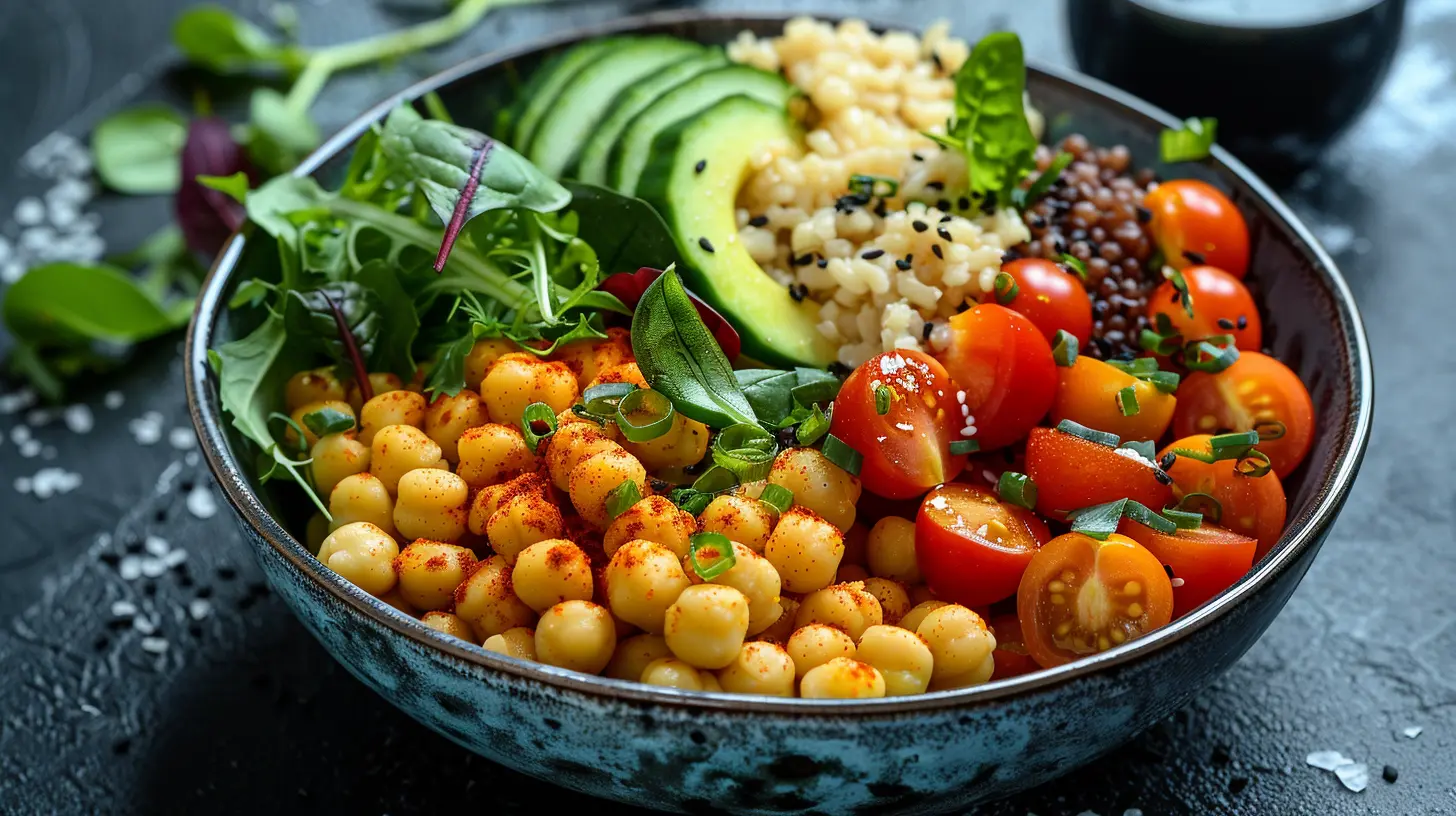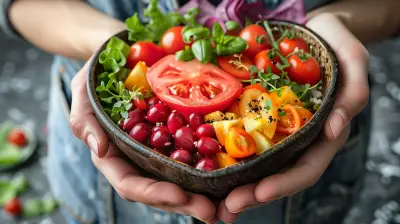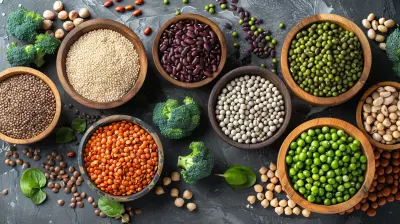How to Create a Balanced Vegan Plate
21 November 2025
Switching to a vegan diet can be incredibly rewarding, but if you’re not careful, you might find yourself lacking essential nutrients. Building a well-balanced vegan plate isn't just about avoiding animal products—it's about ensuring you’re getting all the nutrients your body needs to thrive. Whether you’re new to plant-based eating or a seasoned vegan looking to refine your meals, this guide will help you perfect your plate! 
Why Balance Matters in a Vegan Diet
When eating plant-based, balance is key. You need to cover all your macronutrient bases—proteins, carbs, and fats—while also ensuring you get vitamins and minerals critical for optimal health.A well-structured vegan plate helps:
✅ Maintain energy levels
✅ Support muscle growth and repair
✅ Strengthen immunity
✅ Improve digestion
✅ Promote overall well-being
But how do you actually build a balanced vegan meal? Good news—it’s easier than you think! 
The Simple Formula for a Balanced Vegan Plate
Think of your plate as a pie chart divided into four essential parts:1. Protein Powerhouses (¼ of your plate)
2. Nutrient-Dense Carbohydrates (¼ of your plate)
3. Colorful Vegetables & Fiber (½ of your plate)
4. Healthy Fats for Flavor & Function
1. Protein Powerhouses (¼ of Your Plate)
Protein isn’t just for bodybuilders—it’s essential for everyone! It helps repair tissues, build muscles, and keep you feeling full longer. Luckily, plants pack a protein punch.Great vegan protein sources include:
- Legumes – Lentils, chickpeas, black beans
- Tofu & Tempeh – High in protein and versatile
- Seitan – A wheat-based meat alternative packed with protein
- Quinoa – A complete protein containing all nine essential amino acids
- Edamame – Young soybeans, a great source of plant-based protein
- Nuts & Seeds – Almonds, sunflower seeds, chia, hemp, and flaxseeds
💡 Tip: If you’re looking to boost your protein intake, try adding nutritional yeast—it has a cheesy flavor and provides extra amino acids.
2. Nutrient-Dense Carbohydrates (¼ of Your Plate)
Carbs often get a bad rap, but they’re actually your body’s main source of energy. The key is to choose complex, fiber-rich carbs that digest slowly and keep you energized longer.Best plant-based carb sources include:
- Whole Grains – Brown rice, quinoa, bulgur, farro, whole wheat bread
- Root Vegetables – Sweet potatoes, carrots, beets
- Starchy Vegetables – Peas, corn, winter squash
- Legumes – Beans, lentils (bonus: they provide protein, too!)
These foods provide fiber, keep blood sugar stable, and prevent those midday energy crashes.
💡 Tip: Ditch refined grains (like white pasta and white rice) in favor of whole grains for better digestion and sustained energy.
3. Colorful Vegetables & Fiber (½ of Your Plate)
Vegetables are loaded with vitamins, minerals, antioxidants, and fiber—making them an essential part of every meal. Aim for a variety of colors to get a wide range of nutrients.Best veggies to include:
- Leafy Greens – Spinach, kale, Swiss chard (rich in iron and calcium)
- Cruciferous Vegetables – Broccoli, cauliflower, Brussels sprouts (great for detoxification)
- Red & Orange Veggies – Carrots, bell peppers, tomatoes (high in beta carotene)
- Fermented Foods – Sauerkraut, kimchi, miso (good for gut health)
💡 Tip: Eating a variety of colors ensures you get different antioxidants that help fight inflammation and support overall health.
4. Healthy Fats for Flavor & Function
Fats are essential for absorbing fat-soluble vitamins (like A, D, E, and K), supporting brain function, and keeping your hormones balanced.Healthy vegan fat sources include:
- Avocados – A creamy, nutrient-dense option
- Nuts & Seeds – Walnuts, almonds, chia, flaxseeds (rich in omega-3s)
- Olive Oil & Coconut Oil – Great for cooking and salad dressings
- Nut Butters – Peanut butter, almond butter for extra creaminess
💡 Tip: Omega-3 fatty acids are harder to get on a vegan diet, so include flaxseeds, chia seeds, and walnuts regularly. 
Essential Micronutrients to Watch
A well-balanced vegan plate provides most nutrients, but a few require special attention:Vitamin B12
- Needed for nerve function and red blood cell production.- Found in: Fortified cereals, plant milks, and supplements.
Iron
- Important for oxygen transport in your blood.- Found in: Lentils, tofu, spinach, quinoa.
- Tip: Pairing iron-rich foods with vitamin C (like citrus fruits) enhances absorption.
Calcium
- Crucial for bone health.- Found in: Kale, bok choy, fortified plant milks, tahini.
Omega-3 Fatty Acids
- Supports brain function and heart health.- Found in: Chia seeds, flaxseeds, hemp seeds, walnuts.
Zinc
- Helps with immune function and healing.- Found in: Pumpkin seeds, lentils, chickpeas, cashews.

Meal Planning Tips for a Perfect Vegan Plate
Trying to put it all together? Here’s how to make meal planning simple and delicious:✅ Use the “Plate Method” – Every meal should have protein, carbs, vegetables, and healthy fats.
✅ Batch Cook – Prepare grains, legumes, and chopped veggies in advance for easy assembly.
✅ Stay Stocked Up – Keep pantry staples like canned beans, quinoa, nuts, and seeds handy.
✅ Experiment with Spices – Flavor your food using garlic, ginger, cumin, turmeric, and herbs.
✅ Balance Your Snacks – Pair carbs with protein or fat (think apple slices with almond butter).
💡 Tip: If you’re in a hurry, a smoothie with plant-based milk, hemp seeds, spinach, banana, and nut butter can be a quick and balanced meal!
Sample Balanced Vegan Meals
Here are some meal ideas to keep you inspired:Breakfast
🥑 Tofu Scramble with Whole-Grain Toast – High in protein and fiber🥣 Overnight Oats with Chia Seeds & Almond Butter – A delicious energy boost
Lunch
🥗 Quinoa Salad with Chickpeas, Avocado & Lemon Dressing – Fresh and packed with nutrients🌯 Black Bean & Sweet Potato Burrito – A perfect balance of protein, carbs, and fiber
Dinner
🍛 Lentil & Spinach Curry with Brown Rice – Protein-rich and comforting🥘 Stir-Fried Tempeh with Broccoli & Cashews – A tasty and nutrient-dense meal
Final Thoughts
Creating a balanced vegan plate doesn’t have to be complicated. By including a good mix of protein, healthy carbs, colorful vegetables, and essential fats, you’ll fuel your body with everything it needs to thrive. It’s all about variety, smart food choices, and keeping things simple.Next time you build your meal, take a moment to check—does your plate have all the essentials? If yes, you’re on track to living a healthy and vibrant vegan life!
all images in this post were generated using AI tools
Category:
Healthy RecipesAuthor:

Tiffany Foster

